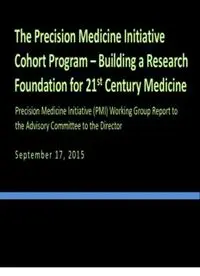
The Precision Medicine Initiative Cohort Program PDF
Preview The Precision Medicine Initiative Cohort Program
The Precision Medicine Initiative Cohort Program – Building a Research st Foundation for 21 Century Medicine Precision Medicine Initiative (PMI) Working Group Report to the Advisory Committee to the Director S e p t e m b e r 1 7 , 2 0 1 5 Kathy Hudson, PhD (NIH) Rick Lifton, MD, PhD (Yale) Bray Patrick-Lake, MFS (Duke) Josh Denny, MD, MS (Vanderbilt) “And that’s why we’re here today. Because something called precision medicine … gives us one of the greatest opportunities for new medical breakthroughs that we have ever seen.” President Barack Obama January 30, 2015 2 Mission of the Precision Medicine Initiative To enable a new era of medicine through research, technology, and polices that empower patients, researchers, and providers to work together toward development of individualized treatments. 3 PMI Proposed Support: FY16 Agency $ Million NIH $200 • Cancer $70 • Cohort $130 FDA $10 ONC $5 TOTAL $215 PMI Working Group of the Advisory Committee to the NIH Director (ACD) Working Group Charge: develop a vision for the PMI Cohort Program (PMI-CP) and advise on the design of a longitudinal national research cohort of ≥1 million volunteers Leverage existing cohorts, start from scratch, or hybrid? How to capture the rich diversity in the U.S. population? What data types should be included? What policies need to be in place for maximal benefit? 5 Advisory Committee to the NIH Director Working Group On Building A Research Cohort For Precision Medicine Co-Chairs: Richard Lifton, MD, PhD, Yale Univ School of Medicine, New Haven, CT Bray Patrick‐Lake, MFS, Duke Univ, Durham, NC Kathy Hudson, PhD, National Institutes of Health Members: • Esteban Gonzalez Burchard, MD, MPH • Sekar Kathiresan, MD University of California, San Francisco Harvard Medical School, Boston • Tony Coles, MD, MPH • Sachin Kheterpal, MD, MBA Yumanity Therapeutics, Cambridge, MA University of Michigan Medical School, Ann Arbor • Rory Collins, FMedSci • Shiriki Kumanyika, PhD, MPH University of Oxford, UK Perelman School of Medicine, Philadelphia • Andrew Conrad, PhD • Spero M. Manson, PhD Google X, Mountain View, CA University of Colorado, Denver • Josh Denny, MD • P. Pearl O’Rourke, MD Vanderbilt University, Nashville Partners Health Care System, Inc., Boston • Susan Desmond‐Hellmann, MD, MPH • Richard Platt, MD, MSc Gates Foundation, Seattle Harvard Pilgrim Health Care Institute, Boston • Eric Dishman • Jay Shendure, MD, PhD Intel, Santa Clara, CA University of Washington, Seattle • Kathy Giusti, MBA • Sue Siegel Multiple Myeloma Res Foundation, Norwalk, CT GE Ventures & Healthymagination, Menlo Park, CA 6 Inputs Workshops – April 28-29: Unique Scientific Opportunities for the National Research Cohort (NIH) – May 28-29: Digital Health Data in a Million-Person Precision Medicine Initiative (Vanderbilt University, Nashville, TN) – July 1-2: Participant Engagement and Health Equity (NIH, Bethesda, MD) – July 27-28: Mobile and Personal Technologies in Precision Medicine (Intel Corp., Santa Clara, CA) Requests for Information – Building the cohort – Strategies to address community engagement and health disparities FNIH Survey of public perceptions of precision medicine cohort White House Privacy and Trust Principles 7 Why? Discover new biomarkers predictive of individual risk of future disease for many common diseases Understand individual variation in response to therapies Study populations reflecting diversity of the US population Accelerate research across many areas of health and disease Participant engagement and ongoing contact allows follow-up studies to advance understanding of disease mechanisms and targeted clinical trials. 8 Why now? Now – 2014 Ten Years Ago (most recent data) Cost of sequencing a $22,000,000 $1,000 - $5,000 human genome Amount of Time to Sequence a Human 2 years <1 day Genome Number of smart phones 1 million (<2%) 160 million (58%) in the United States EHR Adoption 20-30% >90% (% hospitals) n x 16 Computing Power n Deep Learning 9 Scientific Opportunities in the PMI‐CP Discover new biomarkers predictive of future disease risk Discover determinants of individual variation in response to therapeutics Determine quantitative risk estimates in the population by integrating environmental exposures, genetic factors, and gene-environment interactions Integrate mHealth and sensor technologies Determine clinical impact of loss-of-function mutations on clinical outcome Discover new classifications and relationships among diseases Enable targeted clinical trials of subjects with rich clinical data Make ‘big data’ broadly available to investigators 10
